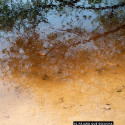El pájaro que escucha. DAVID VÉLEZ
(3Leaves 2012)
El Pájaro Que Escucha, (the bird that listens), is the latest work from David Vélez. Using field recordings from the Colombian coastal town of Palomino Vélez has created a work which provokes an intense emotional response. For one hour Vélez presents a slow stream of sounds from Palomino’s forests and beaches. Central to the tone of this piece are the aircraft whose engines affect the location’s tranquility.
El Pájaro Que Escucha begins with an approaching plane, its low steady drone gradually merging with the intermittent calls of birds in the foreground. An ominous ambience is formed through the encroachment of the engine into the forest’s acoustic space, the tension between the two being clearly audible. The distant sound of the ocean features throughout the piece. During quiet moments in the forest the ocean can be heard in the background, its deep hostile roar eliciting a sensation of dread in the listener. Other sounds heard in El El Pájaro Que Escucha belong to the insect world. The flat-line stridulation of cicadas mirror the drone of the plane, their occasional changes in pitch adding a sense of musicality to the work.
El Pájaro Que Escucha exemplifies the way in which field recordings can be combined to create a particular narrative. Through the strategic sequencing of his recordings Vélez has created an environmentally dystopian work. The calls of the birds create an atmosphere of mournful isolation, as if stemming from earth’s last unspoilt pocket of nature. The plane’s intrusion upon this wilderness adds to the dystopian theme. For the listener it seems logical to connect the fading in and out of the plane with the echo of a past calamity or an impending catastrophe. In the world that Vélez presents even the tropical waves assert an element of menace, increasing the listener’s unease as they resound in the background.
In order to enhance the aural narrative Vélez provides two quotes on the sleeve of the release which are worth considering while listening to El Pájaro Que Escucha. From Sagan ‘For we are the local embodiment of a Cosmos grown to self awareness…Our obligation to survive is owed not just to ourselves but also to that Cosmos ancient and vast, from which we spring’. While from Lyotard ‘…after the sun’s death there won’t be a thought to know that its death took place…That is the sole serious question to face humanity today.’. The relationship between text and sound is clear.
As El Pájaro Que Escucha draws to a close the drone of the plane fades away. In its place Vélez amplifies the world of the forest floor. His exploration of its miniature draws attention to the forest’s complex biophony, reminding us of the fragility of this integrated system. Slowly the focus of the microphone moves upwards to the forest canopy. Here it captures a richer diversity of birdlife than at the beginning of the work. The recordings in this final section are suggestive of the planet’s soundscape before the intrusion of human industry or, conversely, after its demise.
El Pájaro Que Escucha is a profound work. It attains an emotional impact through Vélez’s careful selection of untreated field recordings. The subsequent sonic exploration Vélez takes us on is of a damaged world. Although the recordings were made in Colombia the sounds presented by Vélez are instantly recognisable. The localised recordings of birds, insects, planes and waves allow El Pájaro Que Escucha to reflect the current state of the planet, making the piece as haunting as it is powerful.
-Jay-Dea Lopez



Leave a Reply